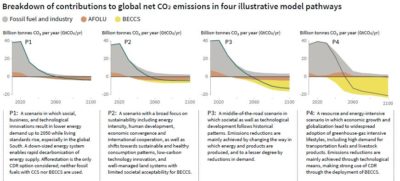Negative Emissions Technologies in the New Report on Limiting Global Warming
The new Intergovernmental Panel on Climate Change report on 1.5°C warming relies heavily on negative emissions technologies.
Last week, I described how the scenarios expected to keep global warming within the 2°C target, which was internationally endorsed in the Paris Agreement, had to assume the use of negative emissions technologies at very large scales. The Intergovernmental Panel on Climate Change (IPCC), an international assessment body, downplayed this essential fact in its most recent major report, and mainstream news reports likewise did so. Yet negative emissions technologies at these scales would have serious environmental and social risks, and might not even be possible.
Today, the IPCC released a special report on the Paris Agreement’s even more ambitious and aspiration target. How does Global Warming of 1.5°C treat negative emissions technologies?
Because atmospheric carbon dioxide is essentially cumulative, ending climate change requires the elimination of net emissions (although previous global warming would persist). Thus, negative emissions technologies can be used both to “cancel out” greenhouse gas emissions as well as to compensate for previous ones if emissions “overshoot” a given target. In the report’s main scenarios — now called “illustrative model pathways” — that would keep warming in 2100 within 1.5°C, net emissions must go to zero around 2050.

Compared with the IPPC’s most recent major report, the combination of a more stringent target and the intervening years of growing emission has increased reliance on both aggressive negative emissions and emissions reductions. In the four “illustrative model pathways” (see image), annual negative emissions are as great as 20 gigatons of carbon dioxide. To give a sense of this scale, current yearly global food production is about four gigatons. Imagine all the world’s crops and livestock, and then multiply their mass by five. This undertaking would be an unprecedented, massive scale. Moreover, if this were to be done through the currently leading negative emissions technology — bioenergy with carbon capture and storage (BECCS) — then huge amounts of arable land would be needed, which would compete with agriculture and in turn drive up food prices. Indeed, the report itself estimates that BECCS’s limit in 2050 as five gigatons per year, which one of its pathways would exceed at that time and another of them soon thereafter.
The scale of necessary negative emissions to stay within 1.5°C depends on the feasibility of ending net greenhouse gas emissions by 2050. Let’s assume the midpoint of estimates of global economic activity at that time, which is about three times the present. The average worldwide annual rate of decarbonization of economic activity would need to be around 10% during the 32 years until then. The current rate (since 2000) is 1.6%, and the highest rates that an individual country has sustained during this time is 3.7%. Nevertheless, one of the report’s scenarios (confusingly called both LED and P1) stays within 1.5°C warming without negative emissions technologies by making numerous optimistic assumptions. These include a dramatic worldwide reduction in meat consumption, which would allow former grazing land to rewild and thus sequester carbon dioxide.
The text of the relevant chapter is honest about large-scale negative emissions, there called “carbon dioxide removal” (CDR):
no CDR technology has been deployed at scale yet, and all come with concerns about their potential…. The literature points to strong limitations to upscaling CDR… and to sustainability constraints…. Large uncertainty hence exists about what amount of CDR could actually be available before mid-century…. Most CDR technologies remain largely unproven to date and raise substantial concerns about adverse side-effects on environmental and social sustainability. (p. 2-31, 2-39)
However, the chapters’ executive summaries are less direct, and the message is largely lost in the important Summary for Policymakers:
1.5°C and 2°C modelled pathways often rely on the deployment of large-scale land-related measures like afforestation and bioenergy supply, which, if poorly managed, can compete with food production and hence raise food security concerns. The impacts of carbon dioxide removal (CDR) options on [Sustainable Development Goals] depend on the type of options and the scale of deployment (high confidence). If poorly implemented, CDR options such as BECCS and (Agriculture, Forestry and Other Land Use) options would lead to trade-offs.
The press release equally lacks clear forthrightness (although the final quoted sentence is somewhat refreshing):
Global net human-caused emissions of carbon dioxide (CO2) would need to fall by about 45 percent from 2010 levels by 2030, reaching ‘net zero’ around 2050. This means that any remaining emissions would need to be balanced by removing CO2 from the air….
Allowing the global temperature to temporarily exceed or ‘overshoot’ 1.5ºC would mean a greater reliance on techniques that remove CO2 from the air to return global temperature to below 1.5ºC by 2100. The effectiveness of such techniques are unproven at large scale and some may carry significant risks for sustainable development, the report notes.
Instead, the headline message should be “Even in optimistic scenarios, keeping warming within 1.5ºC requires carbon-removing technologies that don’t yet exist beyond demonstration, at scales that would have serious negative social and environmental impacts and might indeed not be possible.”
Not surprisingly, the news reports thus far mostly neglect the assumed reliance on negative emissions technologies. Here are the New York Times, BBC News, and The Guardian.
Does this mean that dangerous global warming beyond 1.5 or 2°C is inevitable? No. There appears to be another way, which the report says there is “high agreement that it could limit warming to below 1.5°C.” I’ll describe this in my next post. (NB. now posted: “Another Possible Means To Keep Global Warming Within 1.5 Degrees Celsius“, “Negative Greenhouse Gas Emissions, the National Academies, and the Law“, and “Solar Geoengineering and International Law”)
Reader Comments
One Reply to “Negative Emissions Technologies in the New Report on Limiting Global Warming”
Comments are closed.







Kelp sequesters carbon at a much higher rate than terrestrial vegetation and harbors other life forms that also sequester carbon, often as calcium carbonate, which is removed from the environment for millennia or more.
Using farmed kelp as a source for fuel, or (better for feedstocks which would not be burned such as plastic precursors), would give better than neutral emissions, and more if the carbon dioxide resulting was sequestered. This would also not compete with food production or require wild lands to be brought into cultivation.
Restoration of natural kelp forests and then leaving them alone would sequester much more carbon both as carbonates and ultimately as RDOM in the deep ocean. In the Pacific this would require mainly sea otter restoration, which is a lot less expensive than anything else that could be done, and involves a “charismatic megafauna” which makes things easier. Otters could be the equivalent symbol to the panda for ocean carbon sequestration.